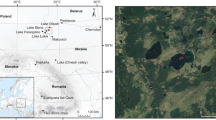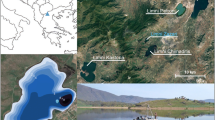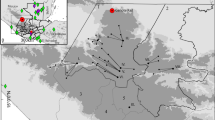Abstract
Understanding the interplay between climatic and anthropogenic factors is a major challenge in palaeo-ecology. In particular, it is often difficult to distinguish anthropogenic and “natural” fire in the charcoal record. In this paper, analysis of fossil pollen, charcoal, diatoms and isotopic evidence from Mapimbi, a small lake in the Kruger National Park, South Africa, suggests that for most of the past ca. 700 years, the riverine gallery forests surrounding Mapimbi were primarily influenced by climate, and benefited during warmer, wetter periods. The transitions between four, statistically different phases in the time-series data coincide with regional climate records previously constructed from speleothem data, and are consistent with the transition from the medieval warm period ending in the 14th century a.d. to the cooler, drier conditions prevailing during the little ice age of ca. a.d. 1400–1800. The data also suggest a period of significant, anthropogenic influence after a.d. 1800, when maize was grown and the incidence of localised fires increased. An increase in woody cover in recent decades may be associated with the management of the area by Kruger National Park. A decline in cultivation occurred in the end of the 20th century linked with changes in socio-political organisation.







Similar content being viewed by others
References
Aaby B, Digerfeldt G (1986) Sampling techniques for lakes and bogs. In: Berglund BE (ed) Handbook of Holocene Palaeoecology and Palaeohydrology. Wiley, Chichester, pp 181–194
Adger WN (2000) Social and ecological resilience: are they related? Prog Hum Geogr 24:347–364
Battarbee RW, Cameron NG, Golding P, Brooks SJ, Switsur R, Harkness D, Appleby P, Oldfield F, Thompson R, Monteith DT, McGovern A (2001) Evidence for Holocene climate variability from the sediments of a Scottish remote mountain lake. J Quat Sci 16:339–346
Bennett KD (1996) Determination of the number of zones in a biostratigraphical sequence. New Phytol 132:155–170
Bennett KD (2008) Psimpoll 4.26. http://www.chrono.qub.ac.uk/psimpoll/psimpoll.html
Bennett KD, Willis KJ (2001) Pollen. In: Smol JP, Birks HJB, Last WM (eds) Tracking environmental change using lake sediments. Kluwer, Dordrecht, pp 355–361
Berkes F, Folke C (eds) (1998) Linking social and ecological systems: management practices and social mechanisms for building resilience. Cambridge University Press, New York
Bird MI, Giresse P, Chivas AR (1994) Effect of forest and savanna vegetation on the carbon-isotope composition of sediments from the Sanaga River, Cameroon. Limnol Oceanogr 39:1845–1854
Birks HJB, Gordon AD (1985) Numerical methods in quaternary pollen analysis. Academic Press, London
Bøe K, Stabell B (2001) Postglacial changes in the groundwater table at Gardemoen, Norway interpreted from diatom analysis. Norsk Geol Tidsskrift 81:235–244
Bonnefille R, Riollet G (1980) Pollens des savannes d’Afrique Orientale. Centre National de la Recherche Scientifique, Paris
Clark JS (1988) Stratigraphic charcoal analysis on petrographic thin sections: application to fire history in Northwestern Minnesota. Quat Res 30:81–91
Clark RL (1982) Point count estimation of charcoal in pollen preparations and thin sections of sediments. Pollen Spores 24:523–535
Cleve-Euler A. Die Diatomeen von Schweden und Finland, vol 1 (1951), vol 2 (1952), vol 3 (1953a), vol 4 (1953b), vol 5 (1955). Almqvist & Wiksell, Stockholm
Crais C (2003) Winds of change: the Eastern Cape in world history. Working paper series no 3. Fort Hare Institute of Social and Economic Research
Czernik J, Goslar T (2001) Preparation of graphite targets in the Gliwice radiocarbon laboratory for AMS 14C dating. Radiocarbon 43:283–291
Duffin KI, Gillson L, Willis KJ (2008) Testing the sensitivity of charcoal as an indicator of fire events in savanna environments: quantitative predictions of fire proximity, area and intensity. Holocene 18:279–291
Ekblom A (2004) Changing landscapes: an environmental history of Chibuene, Southern Mozambique. Dept. of Archaeology and Ancient History, African and Comparative Archaeology, Uppsala
Ekblom A, Stabell B (2008) Paleohydrology of lake Nhaucati (southern Mozambique), 400 AD to present. J Paleolimnol 40:1127–1141
Elton F (1873) J Exploration Limpopo River J Roy Geogr Soc Lond 42:1–49
Fairhead J, Leach M (1996) Misreading the African landscape; society and ecology in a Forest-Savanna mosaic. Cambridge University Press, Cambridge
First R (1983) Black gold: the Mozambican miner, Proletarian and Peasant. St Martin’s Press, Brighton
Foster DR (2000) Conservation lessons and challenges from ecological history. Forest History Today, Fall, pp 2–11
Foster DR, Fluet M, Boose ER (1999) Human or natural disturbance: landscape-scale dynamics of the tropical forests of Puerto Rico. Ecol Appl 9:555–572
Gillson L, Willis KJ (2004) ‘As Earth’s testimonies tell’: wilderness conservation in a changing world. Ecol Lett 7:990–998
Gunderson LH (2000) Ecological resilience—in theory and application. Ann Rev Ecol Syst 31:425–439
Guyer J, Richards P (1996) The invention of biodiversity: social perspectives on the management of biological variety in Africa. Africa 66:1–13
Holling CS (1996) Surprise for science, resilience for ecosystems, and incentives for people. Ecol Appl 6:733–735
Holmgren K, Öberg H (2006) Climate change in southern and eastern Africa during the past millennium and its implications for societal development. Environ Sustain Dev 8:185–195
Holmgren K, Karlén W, Lauritzen SE, Lee-Thorp JA, Partridge TC, Piketh S, Repinski P, Stevenson C, Svanered O, Tyson PD (1999) A 3000-year high-resolution stalagmite-based record of palaeoclimate for northeastern South Africa. Holocene 9:295–309
Holmgren K, Moberg A, Svanered O, Tyson PD (2001) A preliminary 3000-year regional temperature reconstruction for South Africa. South African J Sci 97:49–51
Holmgren K, Lee-Thorp JA, Cooper GRJ, Lundblad K, Partridge TC, Scott L, Sithaldeen R, Talma AS, Tyson PD (2003) Persistent millenial-scale climatic variability over the past 25,000 years in Southern Africa. Quat Sci Rev 22:2311–2326
Huffman TN (1996) Archaeological evidence for climatic change during the last 2000 years in Southern Africa. Quat Int 33:55–60
Hustedt F (1930) Bacillariophyta (Diatomae). In: Pascher A (ed) Süsswasser-Flora Mitteleuropas. Fischer, Jena
Jackson DA (1993) Stopping rules in principal components analysis: a comparison of heuristical and statistical approaches. Ecology 77:2204–2214
Klapwijk M, Huffman T (1996) Excavations at silver leaves: a final report. South African Archaeol Bull 51:84–93
Krammer K, Lange-Bertalot H (1988) Sü ßwasserflora von Mitteleuropa. Bacillariophyceae. 2. Teil: Bacillariaceae, Epithemiaceae, Surirellaceae. Fischer, Stuttgart
Krammer K, Lange-Bertalot H (1991a) Süßwasserflora von Mittel-europa. Bacillariophyceae. 3. Teil: Centrales, Fragilariaceae, Eunotiaceae. Fischer, Stuttgart
Krammer K, Lange-Bertalot H (1991b) Süßwasserflora von Mittel-europa. Bacillariophyceae. 4. Teil: Achnanthaceae, Kritische Ergänzungen zu Navicula (Lineolatae) und Gomphonema. Fischer, Stuttgart
Küsel A (1992) A preliminary report on settlement layout and gold smelting at Thulamela, a late iron age site in the Kruger National Park. Kodoe 35:246–249
Legendre L, Legendre P (1983) Numerical ecology. Elsevier, Amsterdam
Mabunda D, Pienaar DJ, Verhoef J (2003) The Kruger National park: a century of management and research. In: du Toit JT, Rogers KH, Biggs HC (eds) The Kruger experience. Ecology and management of Savanna heterogeneity. Island Press, Washington, pp 3–21
Manyanga M (2006) Resilient Landscapes, socioenvironmental dynamics in the Shashi-Limpopo basin, southern Zimbabwe c. AD 800 to present. African and Comparative Archaeology, Department of Archaeology and Ancient History, Uppsala University, Uppsala
McCormac FG, Hogg AG, Blackwell PG, Buck CE, Higham TFG, Reimer PJ (2004) SHCal04 Southern hemisphere calibration 0–11.0 cal kyr BP. Radiocarbon 46:1087–1092
McGlade J, van der Leeuw SE (1997) Introduction: archaeology and non-linear dynamics—new approaches to long term change. In: McGlade J, van der Leeuw SE (eds) Time, process and structured transformation in archaeology. Routledge, London, pp 1–32
Meyer A (1984) A profile of the iron age in the Kruger national park. In: Hall M, Avery G, Avery DM, Wilson ML, Humphreys AJB (eds) Frontiers. African Archaeology today, Cambridge, pp 56–59
Meyers PA (1994) Preservation of elemental and isotopic source identification of sedimentary organic matter. Chem Geol 114:289–302
Meyers PA (2003) Application of organic geochemistry to paleolimnological reconstructions: a summary of examples from the Laurentian Great Lakes. Organic Geochem 34:189–261
Midwood A, Boutton T (1998) Soil carbonate decomposition by acid has little effect on d13C of organic matter. Soil Bio Biochem 30:1301–1307
Mitchell P (2003) The Archaeology of Southern Africa. Cambridge University Press, Cambridge
Newitt M (1995) A history of Mozambique. Hurst, London
Nicholson SE (1994) Recent rainfall fluctuations in Africa and their relationship to past conditions over the continent. Holocene 4:121–131
Nicholson SE (2000) The nature of rainfall variability over Africa on time scales of decades to millennia. Global Planet Change 26:137–158
Norström E, Holmgren K (2005) Rainfall driven variations in δ13C composition and wood anatomy of Breonadia salicina trees from South Africa between AD 1375 and 1995. South African J Sci 101:162–168
Pitkänen A, Lehtonen H, Huttunen P (1999) Comparison of sedimentary microscopic charcoal particle records in a small lake with dendrochronological data: evidence for the local origin of microscopic charcoal produced by forest fires of low intensity in eastern Finland. Holocene 9:559–567
Plug I (2000) Overview of Iron age fauna from the Limpopo valley. South Afr Archaeol Soc Goodwin Ser 8:117–126
Pollard S, Shackleton C, Carruthers J (2003) Beyond the fence: people and the lowveld landscape. In: du Toit JT, Rogers KH, Biggs HC (eds) The Kruger experience. Ecology and management of Savanna heterogeneity. Island Press, Washington, pp 422–446
Rogers KH, O’Keeffe J (2003) River heterogeneity: ecosystem structure, function, and management. In: du Toit JT, Rogers KH, Biggs HC (eds) The Kruger experience. Ecology and management of Savanna heterogeneity. Island Press, Washington, pp 189–218
Scott L (1982) A late quaternary pollen record from the transvaal Bushveld, South Africa. Quat Res 17:339–370
Smith JM (2005) Climate change and agropastoral sustainability in the Shashe/Limpopo river basin from AD 900. Faculty of science. University of Witwatersrand, Johannesburg
Stager C (1988) Environmental changes at lake Cheshi, Zambia since 40,000 years B.P. Quat Res 29:54–65
Steyn M, Miller S, Nienaber WC, Loots M (1998) Late iron age gold burials from Thulamela (Pafuri region, Kruger National Park). South Africa Archaeol Bull 53:73–85
Stuiver M, Polach HA (1977) Discussion: reporting of 14C data. Radiocarbon 19:355–363
Stuiver M, Reimer PJ, Reimer RW (2005) Calib 5.0. http://calib.qub.ac.uk/calib/
Sugita S (1994) Pollen representation of vegetation in quaternary sediments: theory and method in patchy vegetation. J Ecol 82:881–897
Sugita S, Gaillard M-J, Broström A (1999) Landscape openness and pollen records: a simulation approach. Holocene 9:409–421
Talbot MR (2001) Nitrogen isotopes in paleolimnology. In: Smol JP, Birks HJB, Last WM (eds) Tracking environmental change using lake sediments. Kluwer, Dordrecht, pp 402–439
Talbot MR, Lærdal T (2000) The late Pleistocene–Holocene paleolimnology of Lake Victoria, East Africa, based upon elemental and isotopic analyses of sedimentary organic matter. J Paleolimnol 23:141–164
Tinner W, Hu SF (2003) Size parameters, size-class distribution and area-number relationship of microscopic charcoal: relevance for fire reconstruction. Holocene 13:291–296
Tomlinson RW (1973) The Inyanga area, an essay in regional biogeography. University of Rhodesia
Troels-Smith J (1955) Characterization of Unconsolidated Sediments. Geological Survey of Denmark IV 3
Tyson PD (1999) Late Quaternary and Holocene palaeoclimates of southern Africa: a synthesis. South Afr J Geol 102:335–349
Tyson PD, Karlén W, Holmgren K, Heiss GA (2000) The little ice age and Medieval warming in South Africa. South Afr J Sci 96:121–126
Tyson PD, Odada EO, Partridge TC (2001) Late quaternary environmental change in Southern Africa. South Afr J Sci 97:139–149
Umbanhowar CE, McGrath MJ (1998) Experimental production and analysis of microscopic charcoal wood, leaves and grasses. Holocene 8:341–346
Venter FJ, Scholes RJ, Eckhardt HC (2003) The abiotic template and its associated vegetation pattern. In: du Toit JT, Rogers KH, Biggs HC (eds) The Kruger experience. Ecology and management of Savanna heterogeneity. Island Press, Washington, pp 83–129
Acknowledgments
The authors thank Kathy Willis, Kristina Duffin, Zara Chidoub and Pia Windland of the Oxford Long-Term Ecology Laboratory. The research was funded by the Trapnell Fund, the Higgins Trapnell Family Foundation and the Andrew W. Mellon Foundation. We are grateful to staff at Scientific Services, Kruger National Park, especially Harry Biggs and Holger Eckhardt, and also to Sean Waller, Gina Ziervogel and SANParks staff for field assistance. Two anonymous referees made helpful comments on the text.
Author information
Authors and Affiliations
Corresponding author
Additional information
Communicated by F. Bittmann.
Rights and permissions
About this article
Cite this article
Gillson, L., Ekblom, A. Untangling anthropogenic and climatic influence on riverine forest in the Kruger National Park, South Africa. Veget Hist Archaeobot 18, 171–185 (2009). https://doi.org/10.1007/s00334-008-0202-6
Received:
Accepted:
Published:
Issue Date:
DOI: https://doi.org/10.1007/s00334-008-0202-6




